Strategic Management for The Australian Agricultural Company
VerifiedAdded on 2023/06/03
|14
|3183
|253
AI Summary
The report discusses strategic management for The Australian Agricultural Company in the context of the agrifood business sector. It includes external and internal analysis, international opportunities, suitable international strategies, appropriate and inappropriate modes of entry, and future strategic direction.
Contribute Materials
Your contribution can guide someone’s learning journey. Share your
documents today.
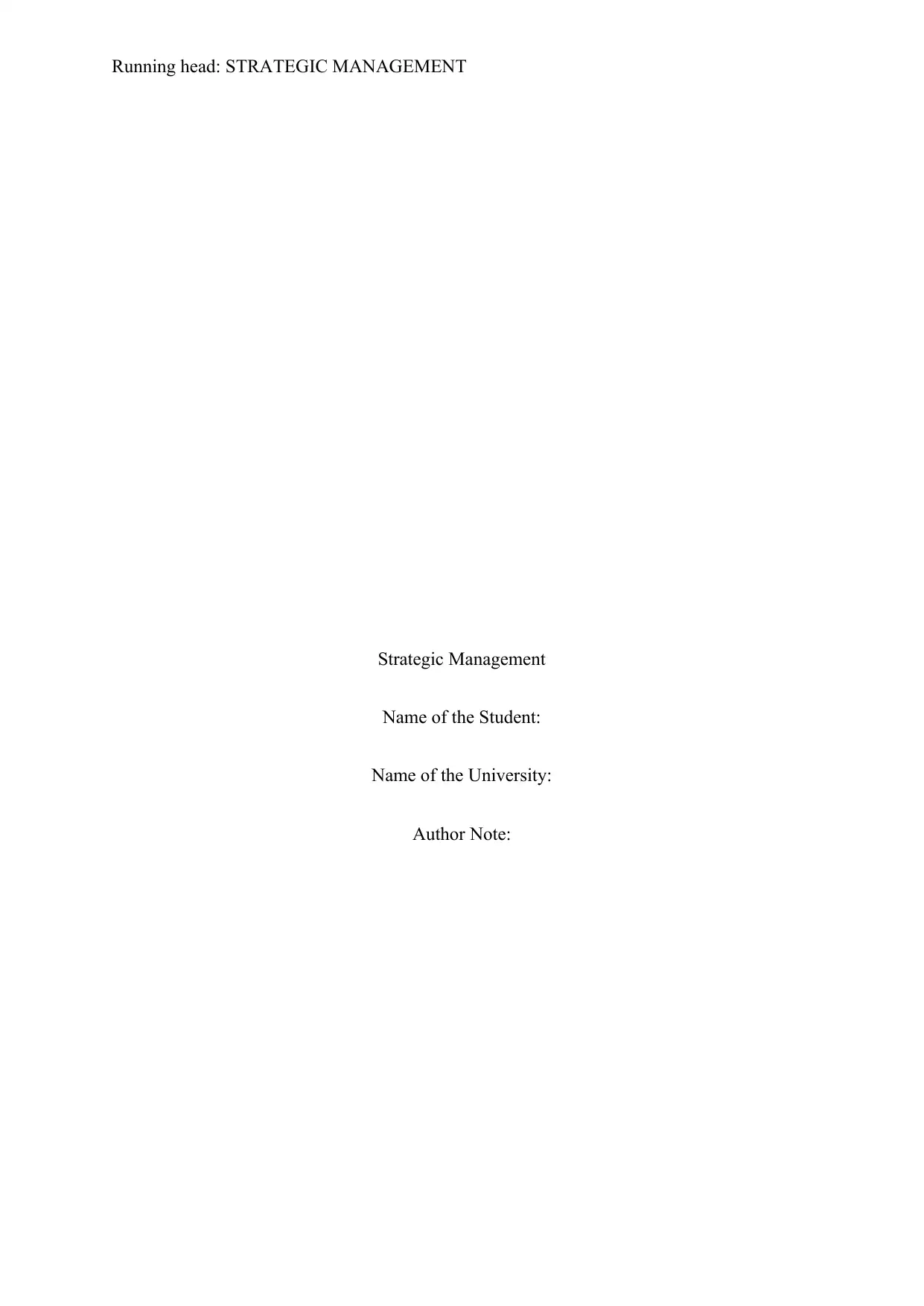
Running head: STRATEGIC MANAGEMENT
Strategic Management
Name of the Student:
Name of the University:
Author Note:
Strategic Management
Name of the Student:
Name of the University:
Author Note:
Secure Best Marks with AI Grader
Need help grading? Try our AI Grader for instant feedback on your assignments.
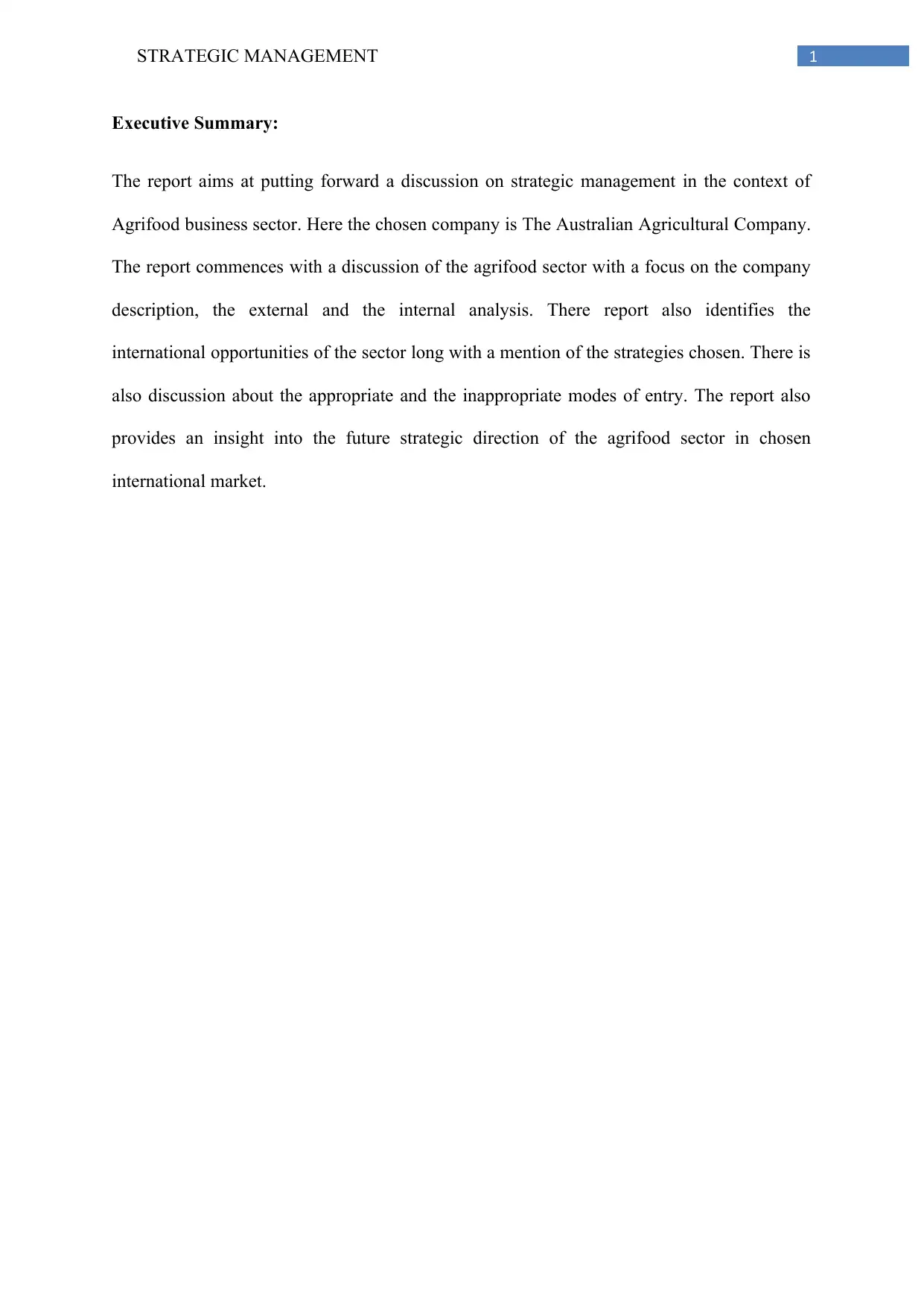
1STRATEGIC MANAGEMENT
Executive Summary:
The report aims at putting forward a discussion on strategic management in the context of
Agrifood business sector. Here the chosen company is The Australian Agricultural Company.
The report commences with a discussion of the agrifood sector with a focus on the company
description, the external and the internal analysis. There report also identifies the
international opportunities of the sector long with a mention of the strategies chosen. There is
also discussion about the appropriate and the inappropriate modes of entry. The report also
provides an insight into the future strategic direction of the agrifood sector in chosen
international market.
Executive Summary:
The report aims at putting forward a discussion on strategic management in the context of
Agrifood business sector. Here the chosen company is The Australian Agricultural Company.
The report commences with a discussion of the agrifood sector with a focus on the company
description, the external and the internal analysis. There report also identifies the
international opportunities of the sector long with a mention of the strategies chosen. There is
also discussion about the appropriate and the inappropriate modes of entry. The report also
provides an insight into the future strategic direction of the agrifood sector in chosen
international market.
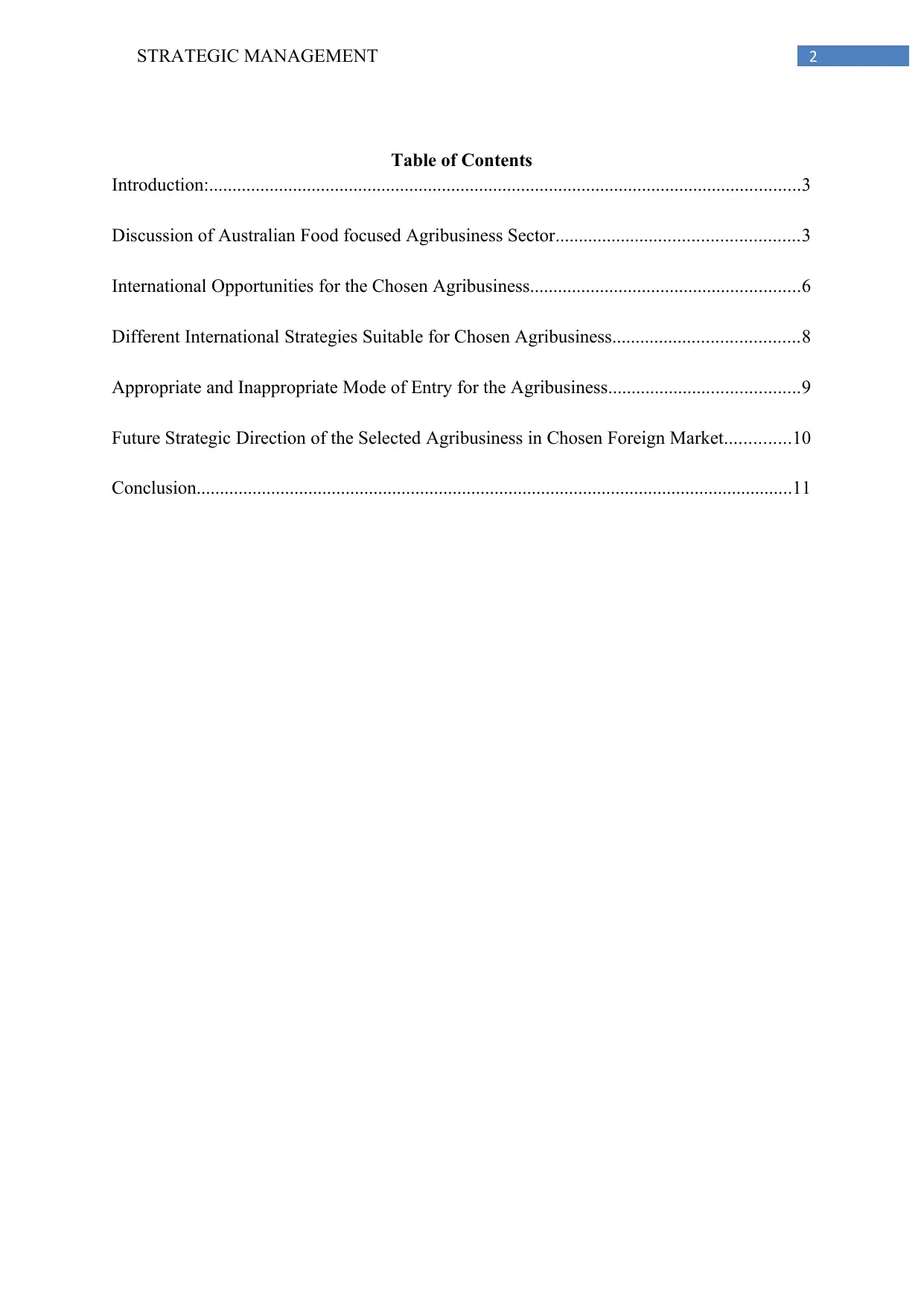
2STRATEGIC MANAGEMENT
Table of Contents
Introduction:...............................................................................................................................3
Discussion of Australian Food focused Agribusiness Sector....................................................3
International Opportunities for the Chosen Agribusiness..........................................................6
Different International Strategies Suitable for Chosen Agribusiness........................................8
Appropriate and Inappropriate Mode of Entry for the Agribusiness.........................................9
Future Strategic Direction of the Selected Agribusiness in Chosen Foreign Market..............10
Conclusion................................................................................................................................11
Table of Contents
Introduction:...............................................................................................................................3
Discussion of Australian Food focused Agribusiness Sector....................................................3
International Opportunities for the Chosen Agribusiness..........................................................6
Different International Strategies Suitable for Chosen Agribusiness........................................8
Appropriate and Inappropriate Mode of Entry for the Agribusiness.........................................9
Future Strategic Direction of the Selected Agribusiness in Chosen Foreign Market..............10
Conclusion................................................................................................................................11
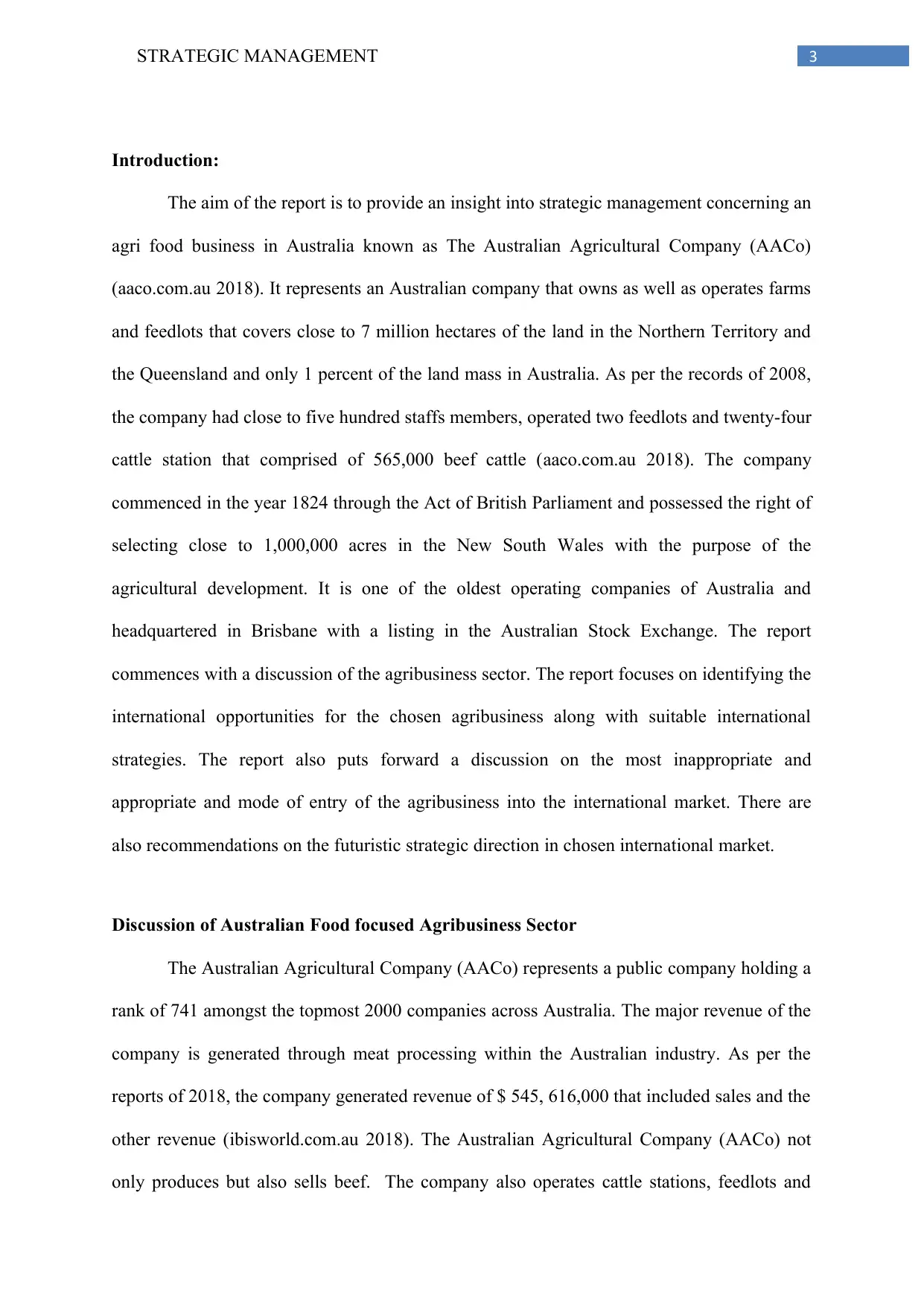
3STRATEGIC MANAGEMENT
Introduction:
The aim of the report is to provide an insight into strategic management concerning an
agri food business in Australia known as The Australian Agricultural Company (AACo)
(aaco.com.au 2018). It represents an Australian company that owns as well as operates farms
and feedlots that covers close to 7 million hectares of the land in the Northern Territory and
the Queensland and only 1 percent of the land mass in Australia. As per the records of 2008,
the company had close to five hundred staffs members, operated two feedlots and twenty-four
cattle station that comprised of 565,000 beef cattle (aaco.com.au 2018). The company
commenced in the year 1824 through the Act of British Parliament and possessed the right of
selecting close to 1,000,000 acres in the New South Wales with the purpose of the
agricultural development. It is one of the oldest operating companies of Australia and
headquartered in Brisbane with a listing in the Australian Stock Exchange. The report
commences with a discussion of the agribusiness sector. The report focuses on identifying the
international opportunities for the chosen agribusiness along with suitable international
strategies. The report also puts forward a discussion on the most inappropriate and
appropriate and mode of entry of the agribusiness into the international market. There are
also recommendations on the futuristic strategic direction in chosen international market.
Discussion of Australian Food focused Agribusiness Sector
The Australian Agricultural Company (AACo) represents a public company holding a
rank of 741 amongst the topmost 2000 companies across Australia. The major revenue of the
company is generated through meat processing within the Australian industry. As per the
reports of 2018, the company generated revenue of $ 545, 616,000 that included sales and the
other revenue (ibisworld.com.au 2018). The Australian Agricultural Company (AACo) not
only produces but also sells beef. The company also operates cattle stations, feedlots and
Introduction:
The aim of the report is to provide an insight into strategic management concerning an
agri food business in Australia known as The Australian Agricultural Company (AACo)
(aaco.com.au 2018). It represents an Australian company that owns as well as operates farms
and feedlots that covers close to 7 million hectares of the land in the Northern Territory and
the Queensland and only 1 percent of the land mass in Australia. As per the records of 2008,
the company had close to five hundred staffs members, operated two feedlots and twenty-four
cattle station that comprised of 565,000 beef cattle (aaco.com.au 2018). The company
commenced in the year 1824 through the Act of British Parliament and possessed the right of
selecting close to 1,000,000 acres in the New South Wales with the purpose of the
agricultural development. It is one of the oldest operating companies of Australia and
headquartered in Brisbane with a listing in the Australian Stock Exchange. The report
commences with a discussion of the agribusiness sector. The report focuses on identifying the
international opportunities for the chosen agribusiness along with suitable international
strategies. The report also puts forward a discussion on the most inappropriate and
appropriate and mode of entry of the agribusiness into the international market. There are
also recommendations on the futuristic strategic direction in chosen international market.
Discussion of Australian Food focused Agribusiness Sector
The Australian Agricultural Company (AACo) represents a public company holding a
rank of 741 amongst the topmost 2000 companies across Australia. The major revenue of the
company is generated through meat processing within the Australian industry. As per the
reports of 2018, the company generated revenue of $ 545, 616,000 that included sales and the
other revenue (ibisworld.com.au 2018). The Australian Agricultural Company (AACo) not
only produces but also sells beef. The company also operates cattle stations, feedlots and
Secure Best Marks with AI Grader
Need help grading? Try our AI Grader for instant feedback on your assignments.
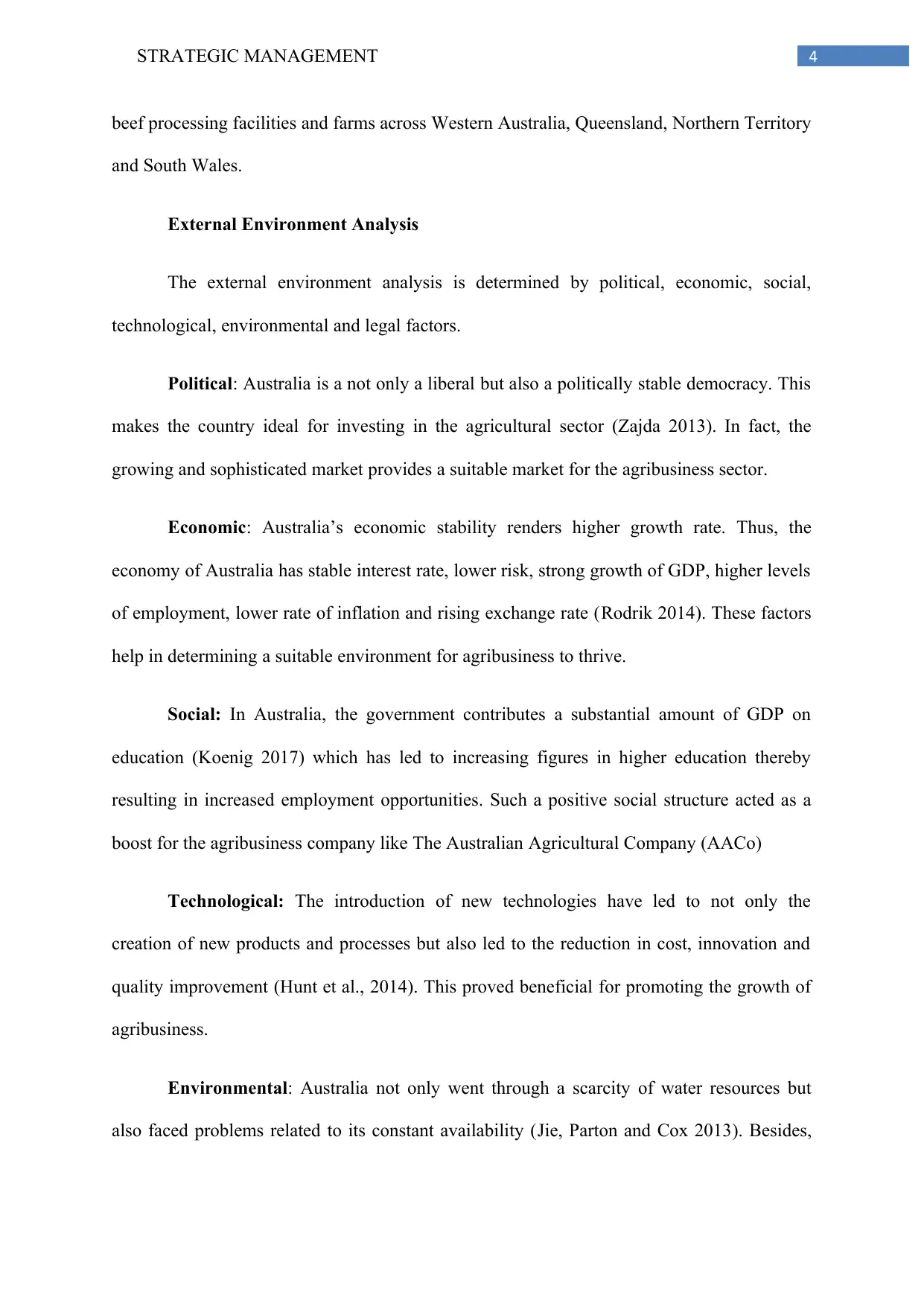
4STRATEGIC MANAGEMENT
beef processing facilities and farms across Western Australia, Queensland, Northern Territory
and South Wales.
External Environment Analysis
The external environment analysis is determined by political, economic, social,
technological, environmental and legal factors.
Political: Australia is a not only a liberal but also a politically stable democracy. This
makes the country ideal for investing in the agricultural sector (Zajda 2013). In fact, the
growing and sophisticated market provides a suitable market for the agribusiness sector.
Economic: Australia’s economic stability renders higher growth rate. Thus, the
economy of Australia has stable interest rate, lower risk, strong growth of GDP, higher levels
of employment, lower rate of inflation and rising exchange rate (Rodrik 2014). These factors
help in determining a suitable environment for agribusiness to thrive.
Social: In Australia, the government contributes a substantial amount of GDP on
education (Koenig 2017) which has led to increasing figures in higher education thereby
resulting in increased employment opportunities. Such a positive social structure acted as a
boost for the agribusiness company like The Australian Agricultural Company (AACo)
Technological: The introduction of new technologies have led to not only the
creation of new products and processes but also led to the reduction in cost, innovation and
quality improvement (Hunt et al., 2014). This proved beneficial for promoting the growth of
agribusiness.
Environmental: Australia not only went through a scarcity of water resources but
also faced problems related to its constant availability (Jie, Parton and Cox 2013). Besides,
beef processing facilities and farms across Western Australia, Queensland, Northern Territory
and South Wales.
External Environment Analysis
The external environment analysis is determined by political, economic, social,
technological, environmental and legal factors.
Political: Australia is a not only a liberal but also a politically stable democracy. This
makes the country ideal for investing in the agricultural sector (Zajda 2013). In fact, the
growing and sophisticated market provides a suitable market for the agribusiness sector.
Economic: Australia’s economic stability renders higher growth rate. Thus, the
economy of Australia has stable interest rate, lower risk, strong growth of GDP, higher levels
of employment, lower rate of inflation and rising exchange rate (Rodrik 2014). These factors
help in determining a suitable environment for agribusiness to thrive.
Social: In Australia, the government contributes a substantial amount of GDP on
education (Koenig 2017) which has led to increasing figures in higher education thereby
resulting in increased employment opportunities. Such a positive social structure acted as a
boost for the agribusiness company like The Australian Agricultural Company (AACo)
Technological: The introduction of new technologies have led to not only the
creation of new products and processes but also led to the reduction in cost, innovation and
quality improvement (Hunt et al., 2014). This proved beneficial for promoting the growth of
agribusiness.
Environmental: Australia not only went through a scarcity of water resources but
also faced problems related to its constant availability (Jie, Parton and Cox 2013). Besides,
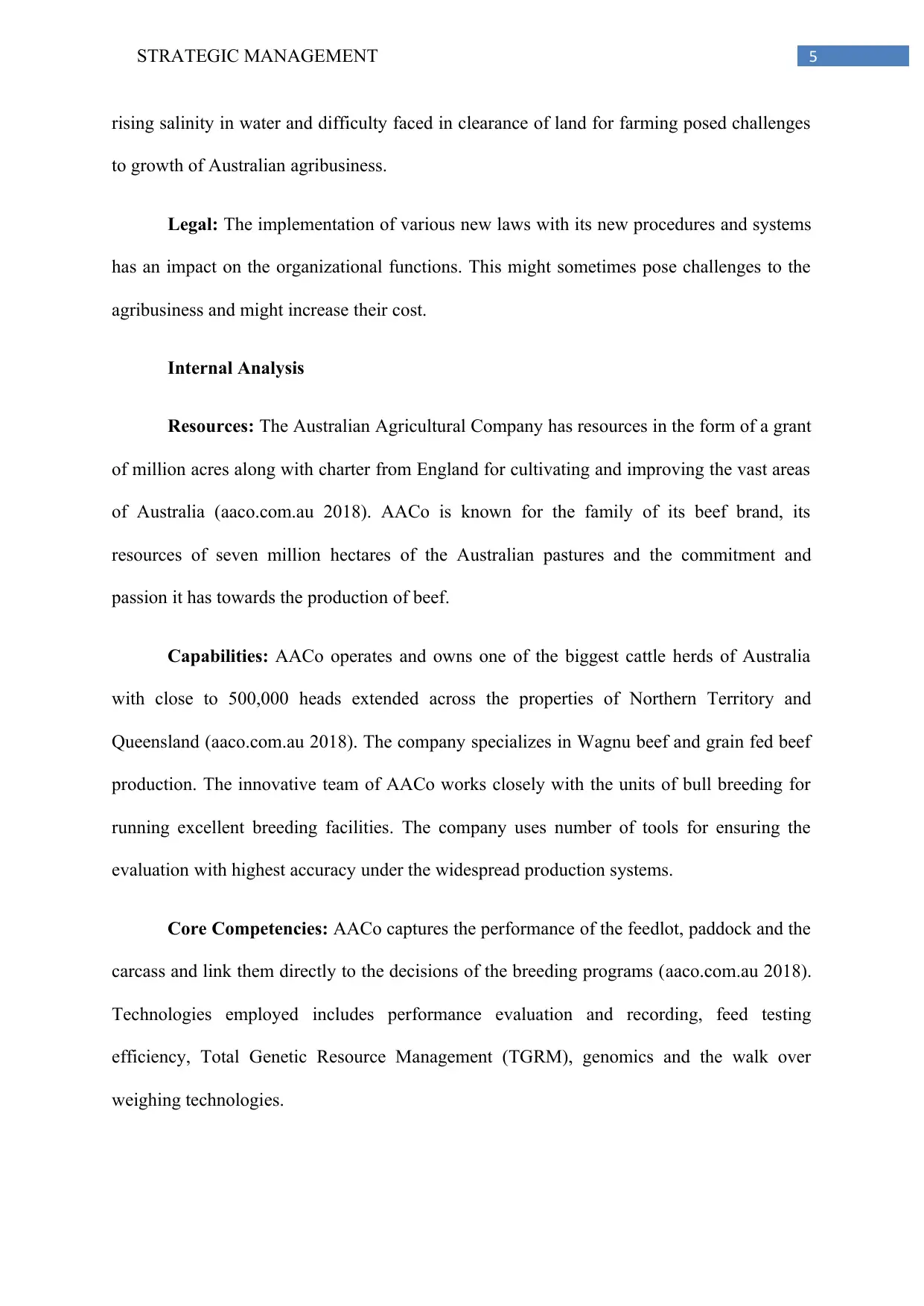
5STRATEGIC MANAGEMENT
rising salinity in water and difficulty faced in clearance of land for farming posed challenges
to growth of Australian agribusiness.
Legal: The implementation of various new laws with its new procedures and systems
has an impact on the organizational functions. This might sometimes pose challenges to the
agribusiness and might increase their cost.
Internal Analysis
Resources: The Australian Agricultural Company has resources in the form of a grant
of million acres along with charter from England for cultivating and improving the vast areas
of Australia (aaco.com.au 2018). AACo is known for the family of its beef brand, its
resources of seven million hectares of the Australian pastures and the commitment and
passion it has towards the production of beef.
Capabilities: AACo operates and owns one of the biggest cattle herds of Australia
with close to 500,000 heads extended across the properties of Northern Territory and
Queensland (aaco.com.au 2018). The company specializes in Wagnu beef and grain fed beef
production. The innovative team of AACo works closely with the units of bull breeding for
running excellent breeding facilities. The company uses number of tools for ensuring the
evaluation with highest accuracy under the widespread production systems.
Core Competencies: AACo captures the performance of the feedlot, paddock and the
carcass and link them directly to the decisions of the breeding programs (aaco.com.au 2018).
Technologies employed includes performance evaluation and recording, feed testing
efficiency, Total Genetic Resource Management (TGRM), genomics and the walk over
weighing technologies.
rising salinity in water and difficulty faced in clearance of land for farming posed challenges
to growth of Australian agribusiness.
Legal: The implementation of various new laws with its new procedures and systems
has an impact on the organizational functions. This might sometimes pose challenges to the
agribusiness and might increase their cost.
Internal Analysis
Resources: The Australian Agricultural Company has resources in the form of a grant
of million acres along with charter from England for cultivating and improving the vast areas
of Australia (aaco.com.au 2018). AACo is known for the family of its beef brand, its
resources of seven million hectares of the Australian pastures and the commitment and
passion it has towards the production of beef.
Capabilities: AACo operates and owns one of the biggest cattle herds of Australia
with close to 500,000 heads extended across the properties of Northern Territory and
Queensland (aaco.com.au 2018). The company specializes in Wagnu beef and grain fed beef
production. The innovative team of AACo works closely with the units of bull breeding for
running excellent breeding facilities. The company uses number of tools for ensuring the
evaluation with highest accuracy under the widespread production systems.
Core Competencies: AACo captures the performance of the feedlot, paddock and the
carcass and link them directly to the decisions of the breeding programs (aaco.com.au 2018).
Technologies employed includes performance evaluation and recording, feed testing
efficiency, Total Genetic Resource Management (TGRM), genomics and the walk over
weighing technologies.
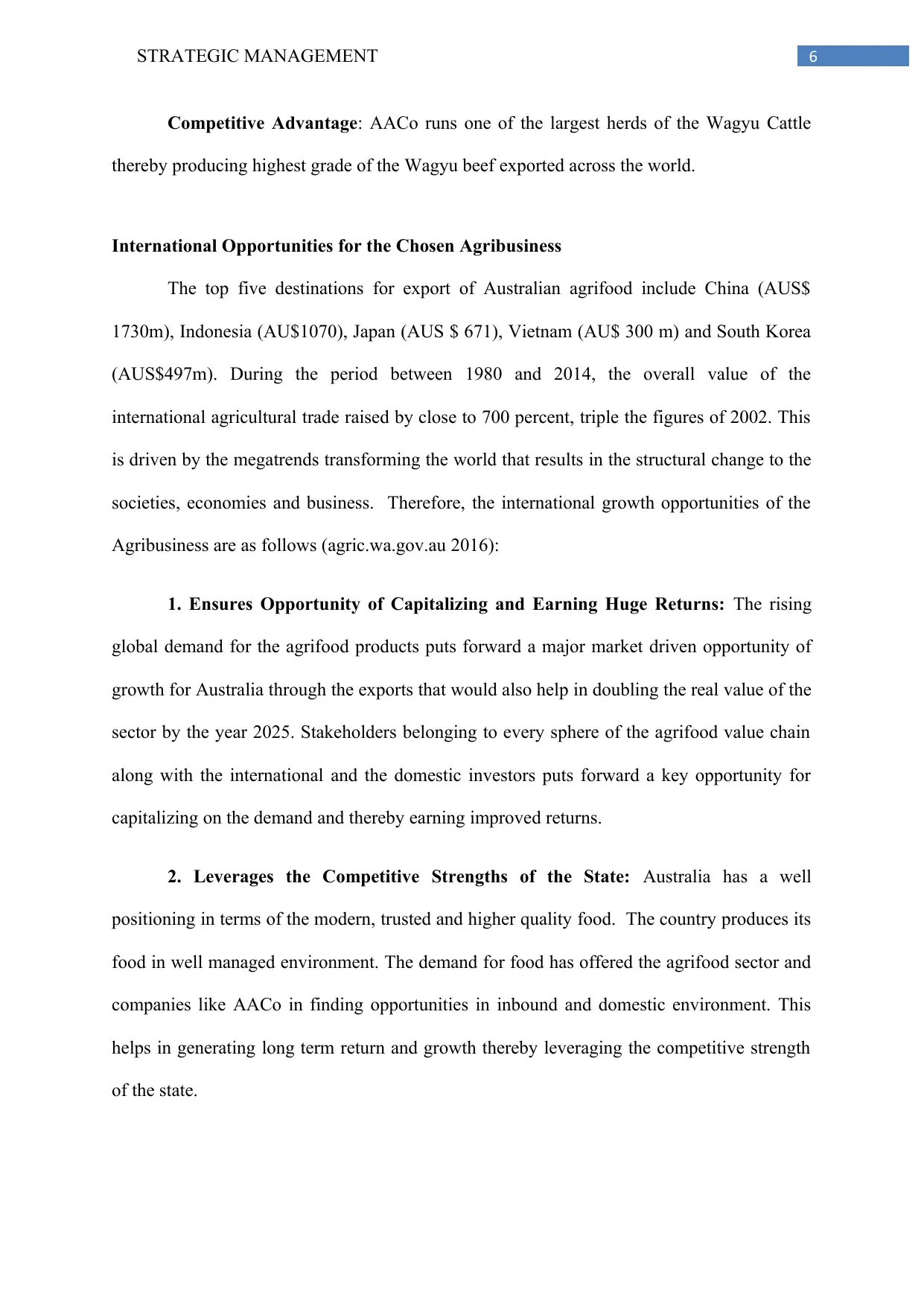
6STRATEGIC MANAGEMENT
Competitive Advantage: AACo runs one of the largest herds of the Wagyu Cattle
thereby producing highest grade of the Wagyu beef exported across the world.
International Opportunities for the Chosen Agribusiness
The top five destinations for export of Australian agrifood include China (AUS$
1730m), Indonesia (AU$1070), Japan (AUS $ 671), Vietnam (AU$ 300 m) and South Korea
(AUS$497m). During the period between 1980 and 2014, the overall value of the
international agricultural trade raised by close to 700 percent, triple the figures of 2002. This
is driven by the megatrends transforming the world that results in the structural change to the
societies, economies and business. Therefore, the international growth opportunities of the
Agribusiness are as follows (agric.wa.gov.au 2016):
1. Ensures Opportunity of Capitalizing and Earning Huge Returns: The rising
global demand for the agrifood products puts forward a major market driven opportunity of
growth for Australia through the exports that would also help in doubling the real value of the
sector by the year 2025. Stakeholders belonging to every sphere of the agrifood value chain
along with the international and the domestic investors puts forward a key opportunity for
capitalizing on the demand and thereby earning improved returns.
2. Leverages the Competitive Strengths of the State: Australia has a well
positioning in terms of the modern, trusted and higher quality food. The country produces its
food in well managed environment. The demand for food has offered the agrifood sector and
companies like AACo in finding opportunities in inbound and domestic environment. This
helps in generating long term return and growth thereby leveraging the competitive strength
of the state.
Competitive Advantage: AACo runs one of the largest herds of the Wagyu Cattle
thereby producing highest grade of the Wagyu beef exported across the world.
International Opportunities for the Chosen Agribusiness
The top five destinations for export of Australian agrifood include China (AUS$
1730m), Indonesia (AU$1070), Japan (AUS $ 671), Vietnam (AU$ 300 m) and South Korea
(AUS$497m). During the period between 1980 and 2014, the overall value of the
international agricultural trade raised by close to 700 percent, triple the figures of 2002. This
is driven by the megatrends transforming the world that results in the structural change to the
societies, economies and business. Therefore, the international growth opportunities of the
Agribusiness are as follows (agric.wa.gov.au 2016):
1. Ensures Opportunity of Capitalizing and Earning Huge Returns: The rising
global demand for the agrifood products puts forward a major market driven opportunity of
growth for Australia through the exports that would also help in doubling the real value of the
sector by the year 2025. Stakeholders belonging to every sphere of the agrifood value chain
along with the international and the domestic investors puts forward a key opportunity for
capitalizing on the demand and thereby earning improved returns.
2. Leverages the Competitive Strengths of the State: Australia has a well
positioning in terms of the modern, trusted and higher quality food. The country produces its
food in well managed environment. The demand for food has offered the agrifood sector and
companies like AACo in finding opportunities in inbound and domestic environment. This
helps in generating long term return and growth thereby leveraging the competitive strength
of the state.
Paraphrase This Document
Need a fresh take? Get an instant paraphrase of this document with our AI Paraphraser
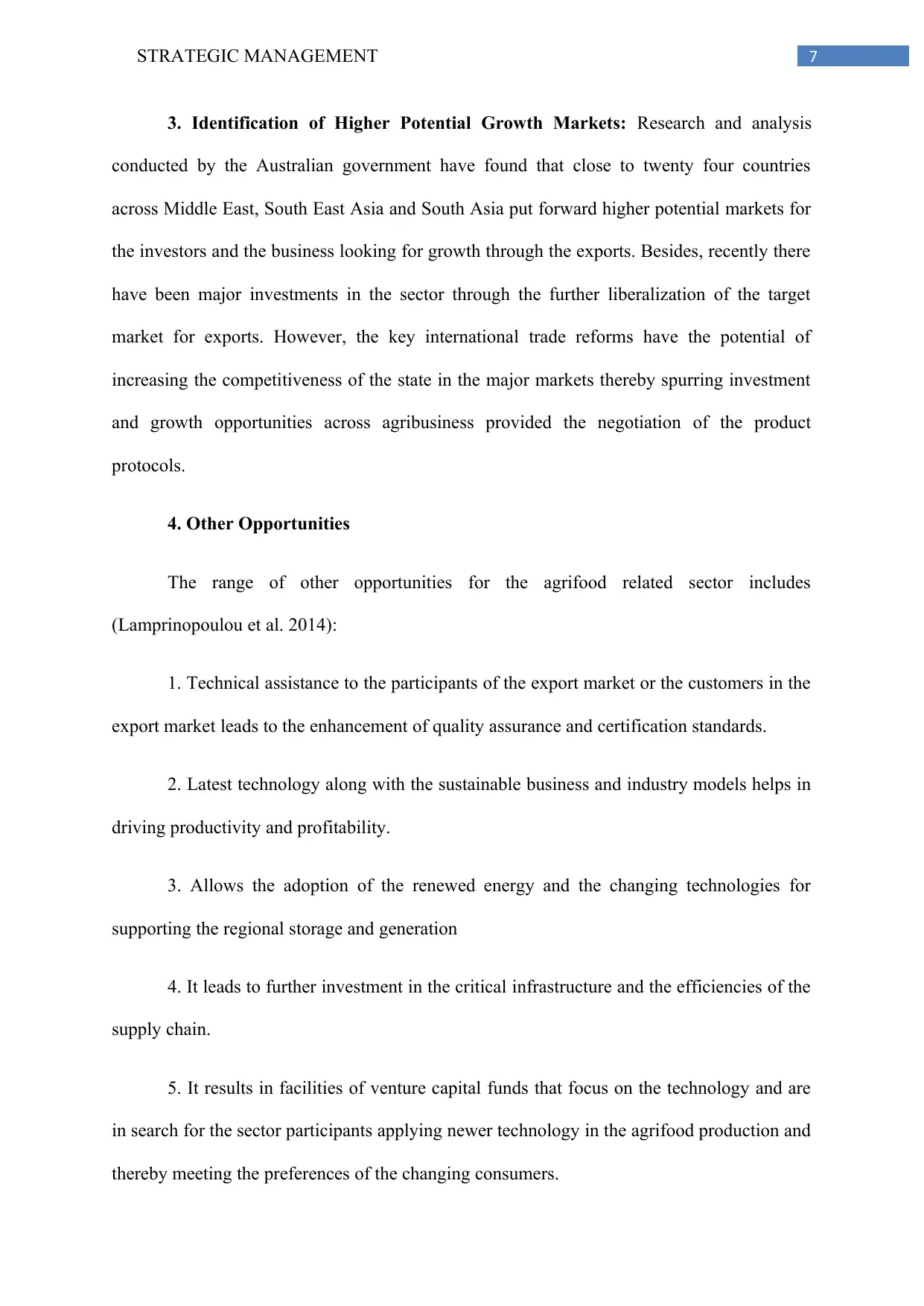
7STRATEGIC MANAGEMENT
3. Identification of Higher Potential Growth Markets: Research and analysis
conducted by the Australian government have found that close to twenty four countries
across Middle East, South East Asia and South Asia put forward higher potential markets for
the investors and the business looking for growth through the exports. Besides, recently there
have been major investments in the sector through the further liberalization of the target
market for exports. However, the key international trade reforms have the potential of
increasing the competitiveness of the state in the major markets thereby spurring investment
and growth opportunities across agribusiness provided the negotiation of the product
protocols.
4. Other Opportunities
The range of other opportunities for the agrifood related sector includes
(Lamprinopoulou et al. 2014):
1. Technical assistance to the participants of the export market or the customers in the
export market leads to the enhancement of quality assurance and certification standards.
2. Latest technology along with the sustainable business and industry models helps in
driving productivity and profitability.
3. Allows the adoption of the renewed energy and the changing technologies for
supporting the regional storage and generation
4. It leads to further investment in the critical infrastructure and the efficiencies of the
supply chain.
5. It results in facilities of venture capital funds that focus on the technology and are
in search for the sector participants applying newer technology in the agrifood production and
thereby meeting the preferences of the changing consumers.
3. Identification of Higher Potential Growth Markets: Research and analysis
conducted by the Australian government have found that close to twenty four countries
across Middle East, South East Asia and South Asia put forward higher potential markets for
the investors and the business looking for growth through the exports. Besides, recently there
have been major investments in the sector through the further liberalization of the target
market for exports. However, the key international trade reforms have the potential of
increasing the competitiveness of the state in the major markets thereby spurring investment
and growth opportunities across agribusiness provided the negotiation of the product
protocols.
4. Other Opportunities
The range of other opportunities for the agrifood related sector includes
(Lamprinopoulou et al. 2014):
1. Technical assistance to the participants of the export market or the customers in the
export market leads to the enhancement of quality assurance and certification standards.
2. Latest technology along with the sustainable business and industry models helps in
driving productivity and profitability.
3. Allows the adoption of the renewed energy and the changing technologies for
supporting the regional storage and generation
4. It leads to further investment in the critical infrastructure and the efficiencies of the
supply chain.
5. It results in facilities of venture capital funds that focus on the technology and are
in search for the sector participants applying newer technology in the agrifood production and
thereby meeting the preferences of the changing consumers.
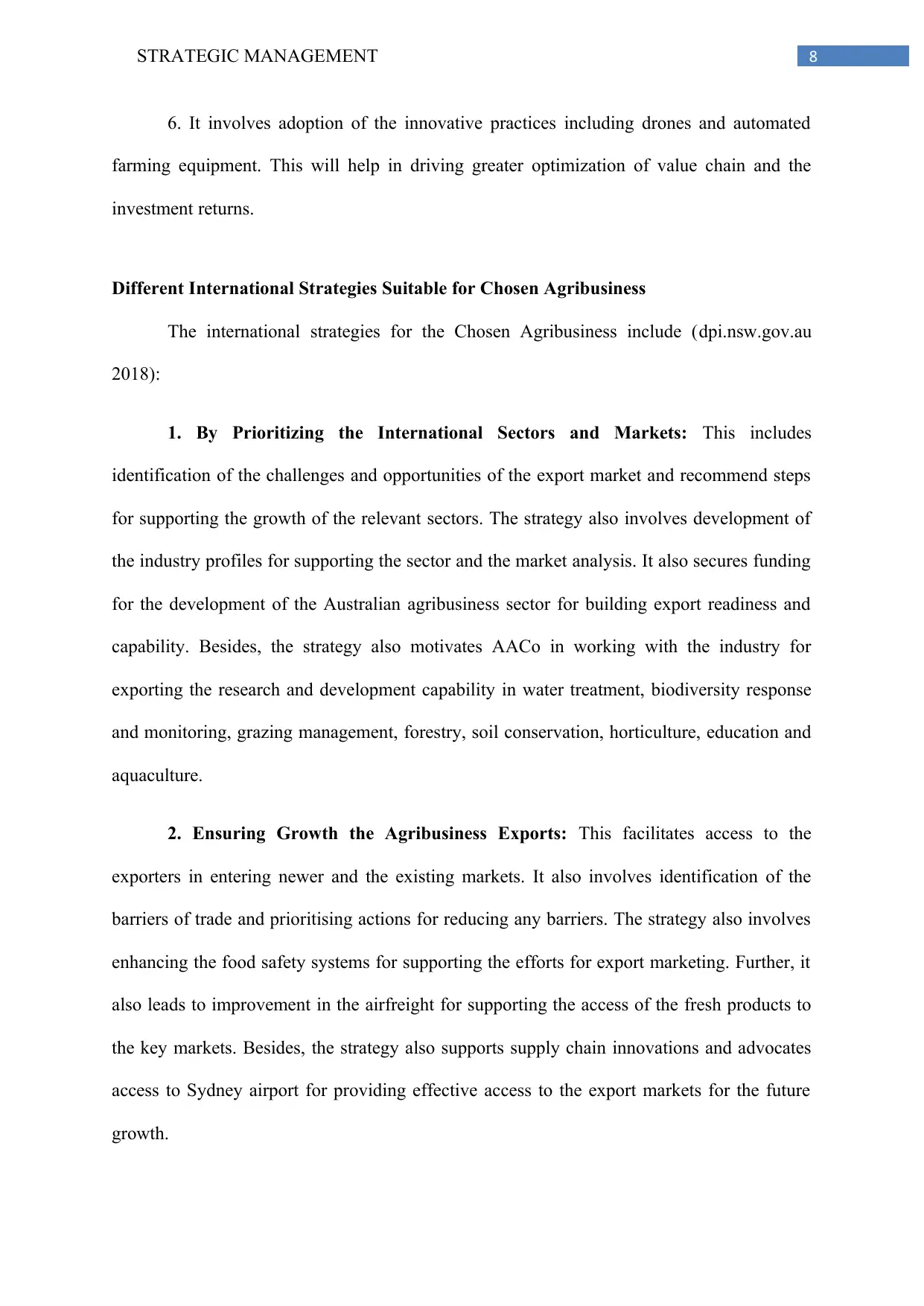
8STRATEGIC MANAGEMENT
6. It involves adoption of the innovative practices including drones and automated
farming equipment. This will help in driving greater optimization of value chain and the
investment returns.
Different International Strategies Suitable for Chosen Agribusiness
The international strategies for the Chosen Agribusiness include (dpi.nsw.gov.au
2018):
1. By Prioritizing the International Sectors and Markets: This includes
identification of the challenges and opportunities of the export market and recommend steps
for supporting the growth of the relevant sectors. The strategy also involves development of
the industry profiles for supporting the sector and the market analysis. It also secures funding
for the development of the Australian agribusiness sector for building export readiness and
capability. Besides, the strategy also motivates AACo in working with the industry for
exporting the research and development capability in water treatment, biodiversity response
and monitoring, grazing management, forestry, soil conservation, horticulture, education and
aquaculture.
2. Ensuring Growth the Agribusiness Exports: This facilitates access to the
exporters in entering newer and the existing markets. It also involves identification of the
barriers of trade and prioritising actions for reducing any barriers. The strategy also involves
enhancing the food safety systems for supporting the efforts for export marketing. Further, it
also leads to improvement in the airfreight for supporting the access of the fresh products to
the key markets. Besides, the strategy also supports supply chain innovations and advocates
access to Sydney airport for providing effective access to the export markets for the future
growth.
6. It involves adoption of the innovative practices including drones and automated
farming equipment. This will help in driving greater optimization of value chain and the
investment returns.
Different International Strategies Suitable for Chosen Agribusiness
The international strategies for the Chosen Agribusiness include (dpi.nsw.gov.au
2018):
1. By Prioritizing the International Sectors and Markets: This includes
identification of the challenges and opportunities of the export market and recommend steps
for supporting the growth of the relevant sectors. The strategy also involves development of
the industry profiles for supporting the sector and the market analysis. It also secures funding
for the development of the Australian agribusiness sector for building export readiness and
capability. Besides, the strategy also motivates AACo in working with the industry for
exporting the research and development capability in water treatment, biodiversity response
and monitoring, grazing management, forestry, soil conservation, horticulture, education and
aquaculture.
2. Ensuring Growth the Agribusiness Exports: This facilitates access to the
exporters in entering newer and the existing markets. It also involves identification of the
barriers of trade and prioritising actions for reducing any barriers. The strategy also involves
enhancing the food safety systems for supporting the efforts for export marketing. Further, it
also leads to improvement in the airfreight for supporting the access of the fresh products to
the key markets. Besides, the strategy also supports supply chain innovations and advocates
access to Sydney airport for providing effective access to the export markets for the future
growth.
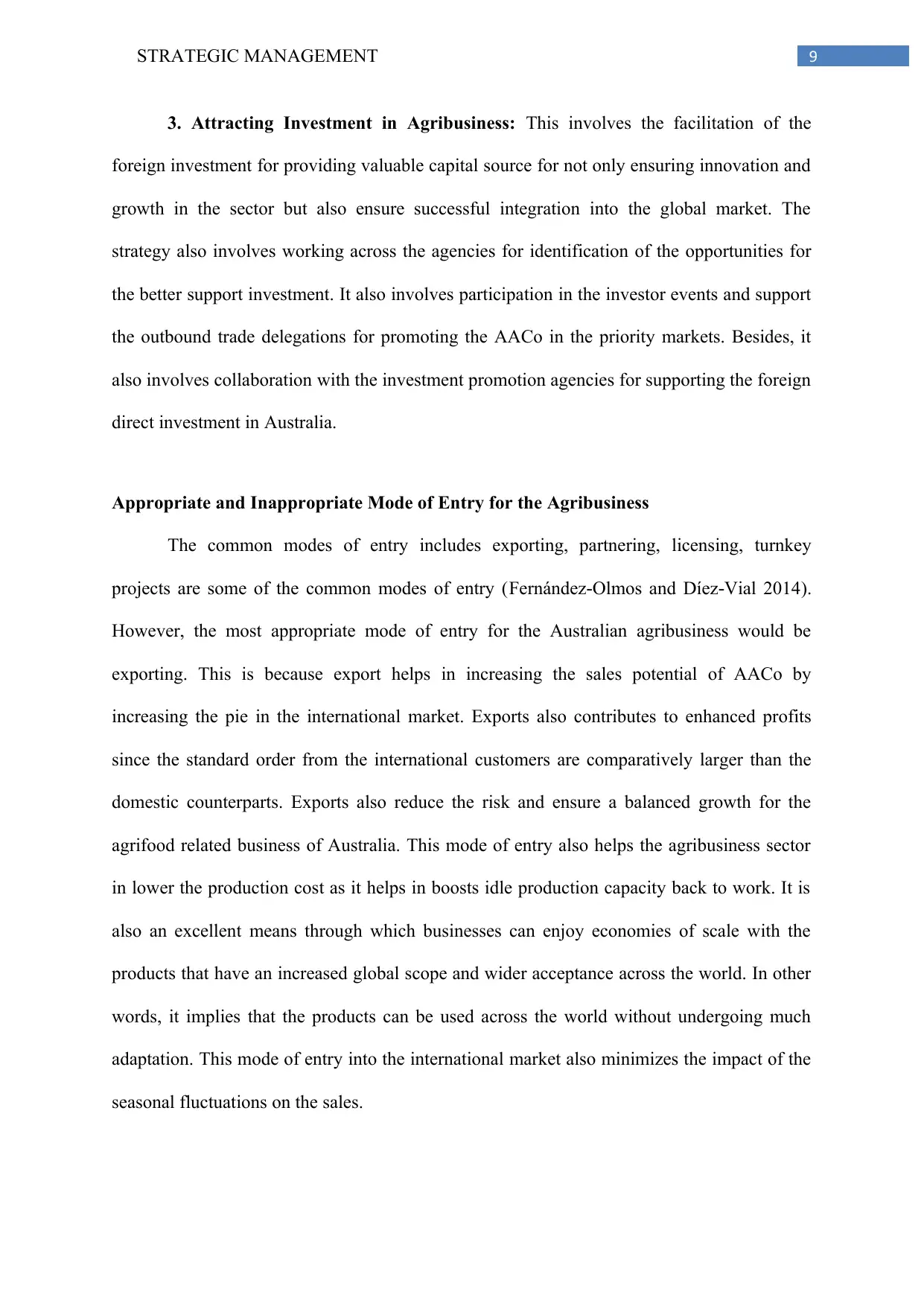
9STRATEGIC MANAGEMENT
3. Attracting Investment in Agribusiness: This involves the facilitation of the
foreign investment for providing valuable capital source for not only ensuring innovation and
growth in the sector but also ensure successful integration into the global market. The
strategy also involves working across the agencies for identification of the opportunities for
the better support investment. It also involves participation in the investor events and support
the outbound trade delegations for promoting the AACo in the priority markets. Besides, it
also involves collaboration with the investment promotion agencies for supporting the foreign
direct investment in Australia.
Appropriate and Inappropriate Mode of Entry for the Agribusiness
The common modes of entry includes exporting, partnering, licensing, turnkey
projects are some of the common modes of entry (Fernández Olmos and Díez Vial 2014‐ ‐ ).
However, the most appropriate mode of entry for the Australian agribusiness would be
exporting. This is because export helps in increasing the sales potential of AACo by
increasing the pie in the international market. Exports also contributes to enhanced profits
since the standard order from the international customers are comparatively larger than the
domestic counterparts. Exports also reduce the risk and ensure a balanced growth for the
agrifood related business of Australia. This mode of entry also helps the agribusiness sector
in lower the production cost as it helps in boosts idle production capacity back to work. It is
also an excellent means through which businesses can enjoy economies of scale with the
products that have an increased global scope and wider acceptance across the world. In other
words, it implies that the products can be used across the world without undergoing much
adaptation. This mode of entry into the international market also minimizes the impact of the
seasonal fluctuations on the sales.
3. Attracting Investment in Agribusiness: This involves the facilitation of the
foreign investment for providing valuable capital source for not only ensuring innovation and
growth in the sector but also ensure successful integration into the global market. The
strategy also involves working across the agencies for identification of the opportunities for
the better support investment. It also involves participation in the investor events and support
the outbound trade delegations for promoting the AACo in the priority markets. Besides, it
also involves collaboration with the investment promotion agencies for supporting the foreign
direct investment in Australia.
Appropriate and Inappropriate Mode of Entry for the Agribusiness
The common modes of entry includes exporting, partnering, licensing, turnkey
projects are some of the common modes of entry (Fernández Olmos and Díez Vial 2014‐ ‐ ).
However, the most appropriate mode of entry for the Australian agribusiness would be
exporting. This is because export helps in increasing the sales potential of AACo by
increasing the pie in the international market. Exports also contributes to enhanced profits
since the standard order from the international customers are comparatively larger than the
domestic counterparts. Exports also reduce the risk and ensure a balanced growth for the
agrifood related business of Australia. This mode of entry also helps the agribusiness sector
in lower the production cost as it helps in boosts idle production capacity back to work. It is
also an excellent means through which businesses can enjoy economies of scale with the
products that have an increased global scope and wider acceptance across the world. In other
words, it implies that the products can be used across the world without undergoing much
adaptation. This mode of entry into the international market also minimizes the impact of the
seasonal fluctuations on the sales.
Secure Best Marks with AI Grader
Need help grading? Try our AI Grader for instant feedback on your assignments.

10STRATEGIC MANAGEMENT
Licensing refers to an inappropriate mode of entry for the agribusiness sector of
Australia as it allows the foreign firms to manufacture the product of the proprietor for a
particular term in a specific market (Laufs and Schwens 2014). This mode of entry is not
suitable for the agribusiness in Australia since it has results in lower income compared to
other modes of entry. This mode of entry might also result in income loss due to the lack of
control of licensee manufacturer over the marketing practices and operations thereby leading
to a loss of the quality. In fact, in licensing there always remains a risk of ruining the
reputation and trademark of the original company by unskilled partner. Besides, the parent
company can face competition from for reign partner especially when they choose the same
place for selling the product.
Future Strategic Direction of the Selected Agribusiness in Chosen Foreign Market
The recommendations are as follows:
1. The future strategic direction of AACo would be building of accurate frameworks
for the maintenance of the profitability, innovation and productivity that will help in
determining the competitiveness of the agribusiness sector in instances of declining terms of
trade.
2. Future strategic direction involves reviewing the business operation and regulatory
environment for enhancing the focus on business development. Besides, it is recommended
for agribusiness in undertaking review of instances of any sort of red tape and duplication.
For example, this included resources like water, labor, labelling, logistics, ingredients and the
market access of the products.
6. To determine a future strategic direction, the agribusiness should be able to create
a support through the protection and enhancement of the social licence of the industry that
Licensing refers to an inappropriate mode of entry for the agribusiness sector of
Australia as it allows the foreign firms to manufacture the product of the proprietor for a
particular term in a specific market (Laufs and Schwens 2014). This mode of entry is not
suitable for the agribusiness in Australia since it has results in lower income compared to
other modes of entry. This mode of entry might also result in income loss due to the lack of
control of licensee manufacturer over the marketing practices and operations thereby leading
to a loss of the quality. In fact, in licensing there always remains a risk of ruining the
reputation and trademark of the original company by unskilled partner. Besides, the parent
company can face competition from for reign partner especially when they choose the same
place for selling the product.
Future Strategic Direction of the Selected Agribusiness in Chosen Foreign Market
The recommendations are as follows:
1. The future strategic direction of AACo would be building of accurate frameworks
for the maintenance of the profitability, innovation and productivity that will help in
determining the competitiveness of the agribusiness sector in instances of declining terms of
trade.
2. Future strategic direction involves reviewing the business operation and regulatory
environment for enhancing the focus on business development. Besides, it is recommended
for agribusiness in undertaking review of instances of any sort of red tape and duplication.
For example, this included resources like water, labor, labelling, logistics, ingredients and the
market access of the products.
6. To determine a future strategic direction, the agribusiness should be able to create
a support through the protection and enhancement of the social licence of the industry that
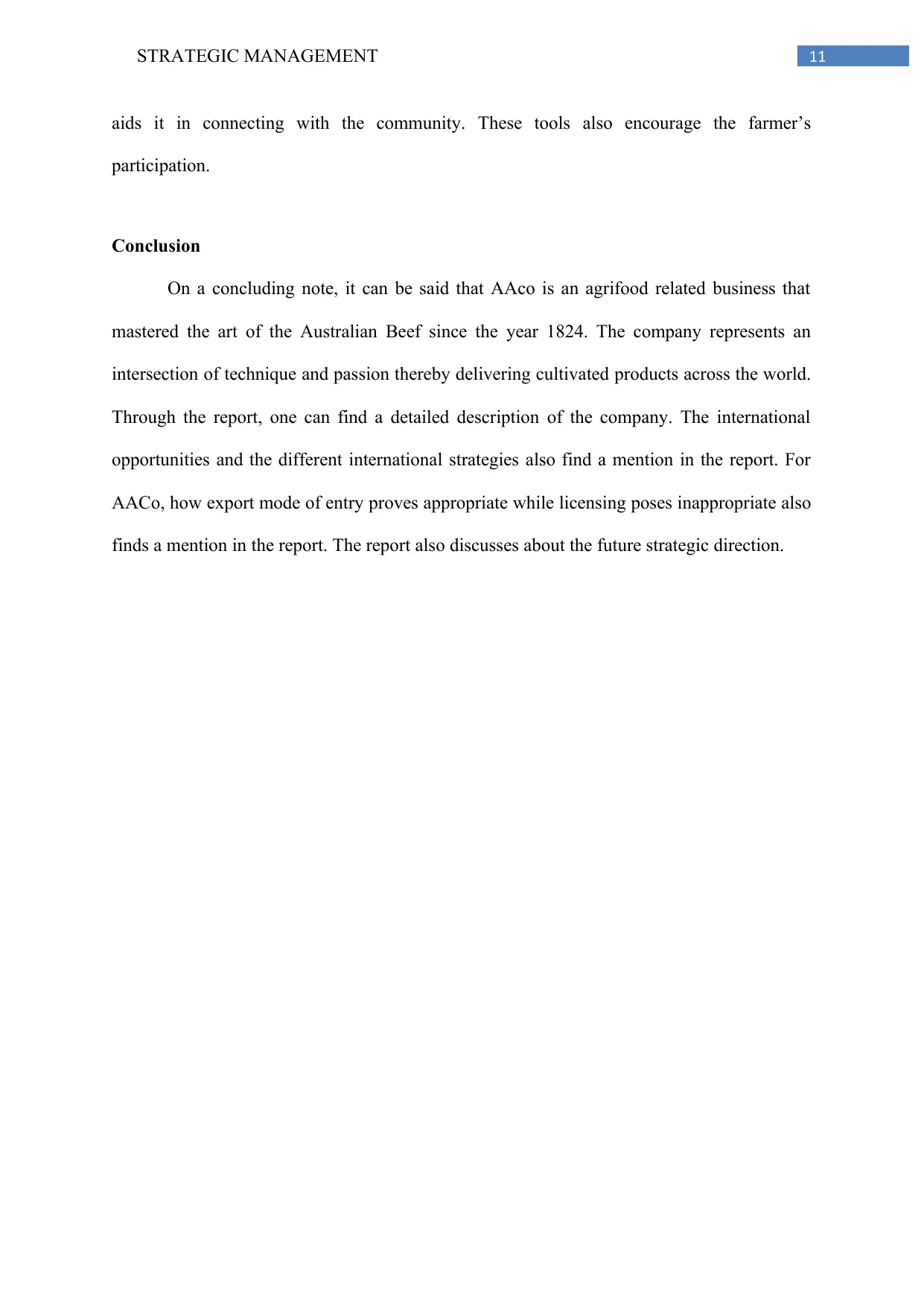
11STRATEGIC MANAGEMENT
aids it in connecting with the community. These tools also encourage the farmer’s
participation.
Conclusion
On a concluding note, it can be said that AAco is an agrifood related business that
mastered the art of the Australian Beef since the year 1824. The company represents an
intersection of technique and passion thereby delivering cultivated products across the world.
Through the report, one can find a detailed description of the company. The international
opportunities and the different international strategies also find a mention in the report. For
AACo, how export mode of entry proves appropriate while licensing poses inappropriate also
finds a mention in the report. The report also discusses about the future strategic direction.
aids it in connecting with the community. These tools also encourage the farmer’s
participation.
Conclusion
On a concluding note, it can be said that AAco is an agrifood related business that
mastered the art of the Australian Beef since the year 1824. The company represents an
intersection of technique and passion thereby delivering cultivated products across the world.
Through the report, one can find a detailed description of the company. The international
opportunities and the different international strategies also find a mention in the report. For
AACo, how export mode of entry proves appropriate while licensing poses inappropriate also
finds a mention in the report. The report also discusses about the future strategic direction.
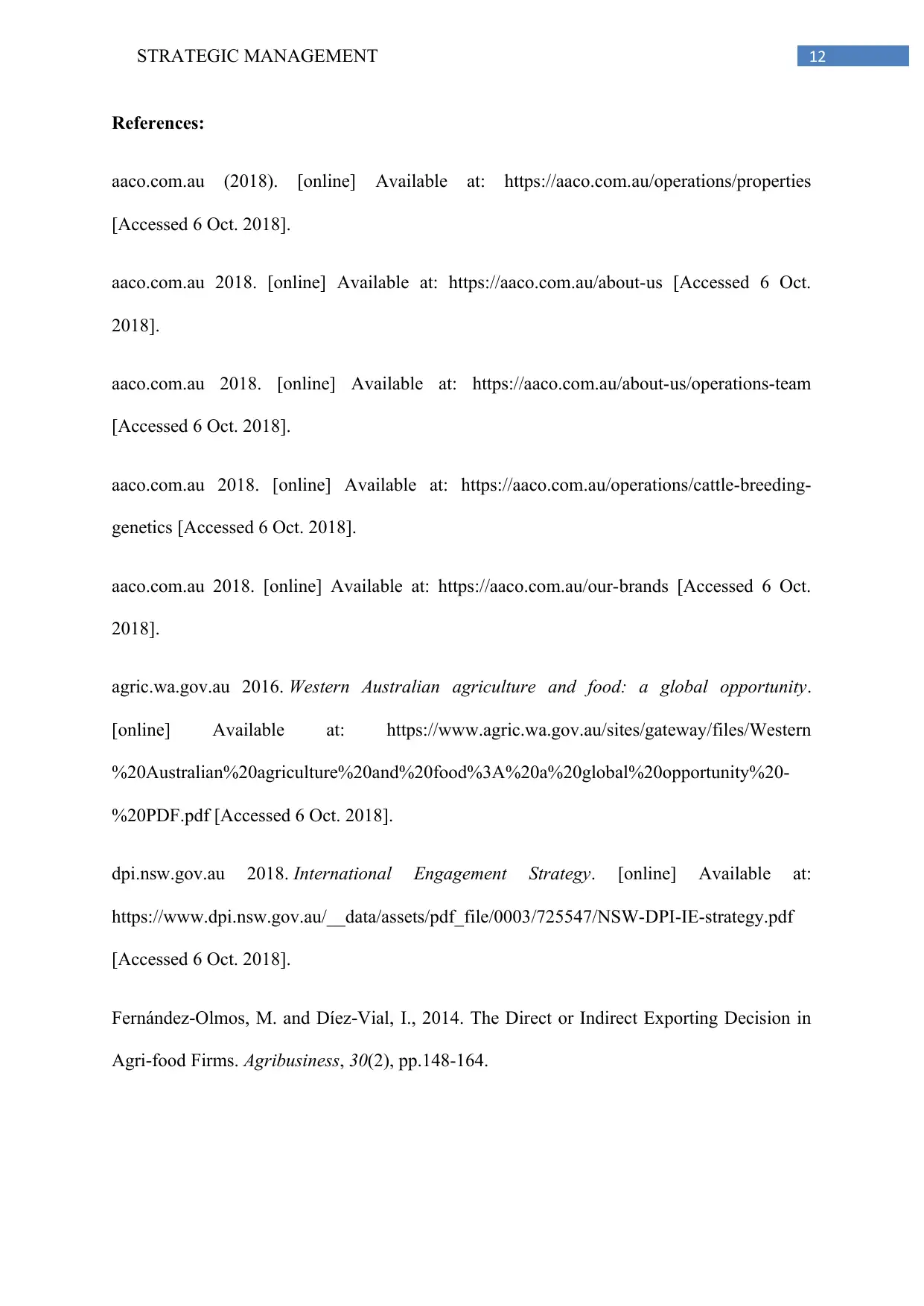
12STRATEGIC MANAGEMENT
References:
aaco.com.au (2018). [online] Available at: https://aaco.com.au/operations/properties
[Accessed 6 Oct. 2018].
aaco.com.au 2018. [online] Available at: https://aaco.com.au/about-us [Accessed 6 Oct.
2018].
aaco.com.au 2018. [online] Available at: https://aaco.com.au/about-us/operations-team
[Accessed 6 Oct. 2018].
aaco.com.au 2018. [online] Available at: https://aaco.com.au/operations/cattle-breeding-
genetics [Accessed 6 Oct. 2018].
aaco.com.au 2018. [online] Available at: https://aaco.com.au/our-brands [Accessed 6 Oct.
2018].
agric.wa.gov.au 2016. Western Australian agriculture and food: a global opportunity.
[online] Available at: https://www.agric.wa.gov.au/sites/gateway/files/Western
%20Australian%20agriculture%20and%20food%3A%20a%20global%20opportunity%20-
%20PDF.pdf [Accessed 6 Oct. 2018].
dpi.nsw.gov.au 2018. International Engagement Strategy. [online] Available at:
https://www.dpi.nsw.gov.au/__data/assets/pdf_file/0003/725547/NSW-DPI-IE-strategy.pdf
[Accessed 6 Oct. 2018].
Fernández Olmos, M. and Díez Vial, I., 2014. The Direct or Indirect Exporting Decision in‐ ‐
Agri food Firms.‐ Agribusiness, 30(2), pp.148-164.
References:
aaco.com.au (2018). [online] Available at: https://aaco.com.au/operations/properties
[Accessed 6 Oct. 2018].
aaco.com.au 2018. [online] Available at: https://aaco.com.au/about-us [Accessed 6 Oct.
2018].
aaco.com.au 2018. [online] Available at: https://aaco.com.au/about-us/operations-team
[Accessed 6 Oct. 2018].
aaco.com.au 2018. [online] Available at: https://aaco.com.au/operations/cattle-breeding-
genetics [Accessed 6 Oct. 2018].
aaco.com.au 2018. [online] Available at: https://aaco.com.au/our-brands [Accessed 6 Oct.
2018].
agric.wa.gov.au 2016. Western Australian agriculture and food: a global opportunity.
[online] Available at: https://www.agric.wa.gov.au/sites/gateway/files/Western
%20Australian%20agriculture%20and%20food%3A%20a%20global%20opportunity%20-
%20PDF.pdf [Accessed 6 Oct. 2018].
dpi.nsw.gov.au 2018. International Engagement Strategy. [online] Available at:
https://www.dpi.nsw.gov.au/__data/assets/pdf_file/0003/725547/NSW-DPI-IE-strategy.pdf
[Accessed 6 Oct. 2018].
Fernández Olmos, M. and Díez Vial, I., 2014. The Direct or Indirect Exporting Decision in‐ ‐
Agri food Firms.‐ Agribusiness, 30(2), pp.148-164.
Paraphrase This Document
Need a fresh take? Get an instant paraphrase of this document with our AI Paraphraser
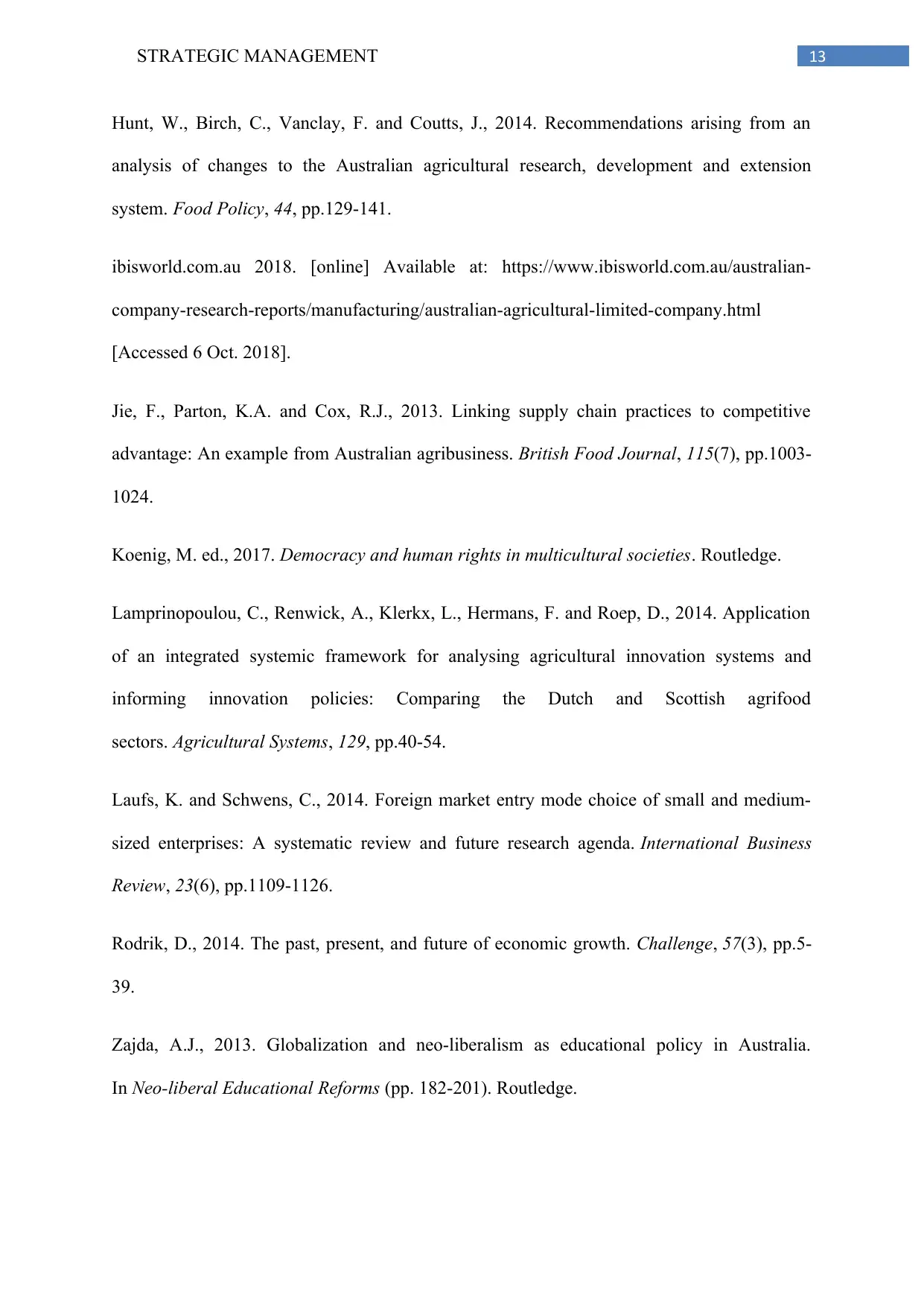
13STRATEGIC MANAGEMENT
Hunt, W., Birch, C., Vanclay, F. and Coutts, J., 2014. Recommendations arising from an
analysis of changes to the Australian agricultural research, development and extension
system. Food Policy, 44, pp.129-141.
ibisworld.com.au 2018. [online] Available at: https://www.ibisworld.com.au/australian-
company-research-reports/manufacturing/australian-agricultural-limited-company.html
[Accessed 6 Oct. 2018].
Jie, F., Parton, K.A. and Cox, R.J., 2013. Linking supply chain practices to competitive
advantage: An example from Australian agribusiness. British Food Journal, 115(7), pp.1003-
1024.
Koenig, M. ed., 2017. Democracy and human rights in multicultural societies. Routledge.
Lamprinopoulou, C., Renwick, A., Klerkx, L., Hermans, F. and Roep, D., 2014. Application
of an integrated systemic framework for analysing agricultural innovation systems and
informing innovation policies: Comparing the Dutch and Scottish agrifood
sectors. Agricultural Systems, 129, pp.40-54.
Laufs, K. and Schwens, C., 2014. Foreign market entry mode choice of small and medium-
sized enterprises: A systematic review and future research agenda. International Business
Review, 23(6), pp.1109-1126.
Rodrik, D., 2014. The past, present, and future of economic growth. Challenge, 57(3), pp.5-
39.
Zajda, A.J., 2013. Globalization and neo-liberalism as educational policy in Australia.
In Neo-liberal Educational Reforms (pp. 182-201). Routledge.
Hunt, W., Birch, C., Vanclay, F. and Coutts, J., 2014. Recommendations arising from an
analysis of changes to the Australian agricultural research, development and extension
system. Food Policy, 44, pp.129-141.
ibisworld.com.au 2018. [online] Available at: https://www.ibisworld.com.au/australian-
company-research-reports/manufacturing/australian-agricultural-limited-company.html
[Accessed 6 Oct. 2018].
Jie, F., Parton, K.A. and Cox, R.J., 2013. Linking supply chain practices to competitive
advantage: An example from Australian agribusiness. British Food Journal, 115(7), pp.1003-
1024.
Koenig, M. ed., 2017. Democracy and human rights in multicultural societies. Routledge.
Lamprinopoulou, C., Renwick, A., Klerkx, L., Hermans, F. and Roep, D., 2014. Application
of an integrated systemic framework for analysing agricultural innovation systems and
informing innovation policies: Comparing the Dutch and Scottish agrifood
sectors. Agricultural Systems, 129, pp.40-54.
Laufs, K. and Schwens, C., 2014. Foreign market entry mode choice of small and medium-
sized enterprises: A systematic review and future research agenda. International Business
Review, 23(6), pp.1109-1126.
Rodrik, D., 2014. The past, present, and future of economic growth. Challenge, 57(3), pp.5-
39.
Zajda, A.J., 2013. Globalization and neo-liberalism as educational policy in Australia.
In Neo-liberal Educational Reforms (pp. 182-201). Routledge.
1 out of 14
Related Documents
Your All-in-One AI-Powered Toolkit for Academic Success.
+13062052269
info@desklib.com
Available 24*7 on WhatsApp / Email
![[object Object]](/_next/static/media/star-bottom.7253800d.svg)
Unlock your academic potential
© 2024 | Zucol Services PVT LTD | All rights reserved.





